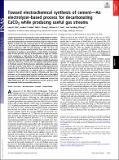Toward electrochemical synthesis of cement—An electrolyzer-based process for decarbonating CaCO₃ while producing useful gas streams
Author(s)
Ellis, Leah D.; Badel, Andres F.; Chiang, Miki L.; Park, Richard J.-Y.; Chiang, Yet-Ming
DownloadPublished version (2.424Mb)
Publisher Policy
Publisher Policy
Article is made available in accordance with the publisher's policy and may be subject to US copyright law. Please refer to the publisher's site for terms of use.
Terms of use
Metadata
Show full item recordAbstract
Cement production is currently the largest single industrial emitter of CO₂, accounting for∼8% (2.8 Gtons/y) of global CO₂ emissions.Deep decarbonization of cement manufacturing will require remediation of both the CO₂ emissions due to the decomposition of CaCO₃ to CaO and that due to combustion of fossil fuels (primarily coal) in calcining (∼900 °C) and sintering (∼1,450 °C). Here, we demonstrate an electrochemical process that uses neutral water electrolysis to produce a pH gradient in which CaCO₃is decarbonated at low pH and Ca(OH)₂ is precipitated at high pH, concurrently producing a high-purity O₂/CO₂ gas mixture (1:2 molarratio at stoichiometric operation) at the anode and H₂ at the cathode. We show that the solid Ca(OH)₂ product readily decomposes and reacts with SiO₂ to form alite, the majority cementitious phasein Portland cement. Electrochemical calcination produces concentrated gas streams from which CO₂ may be readily separated and sequestered, H₂ and/or O₂ may be used to generate electric power via fuel cells or combustors, O₂ may be used as a component ofoxyfuel in the cement kiln to improve efficiency and lower CO₂ emissions, or the output gases may be used for other value-added processes such as liquid fuel production. Analysis shows that if the hydrogen produced by the reactor were combusted to heat the high-temperature kiln, the electrochemical cement process could be powered solely by renewable electricity.
Date issued
2019-09-16Department
Massachusetts Institute of Technology. Department of Materials Science and EngineeringJournal
Proceedings of the National Academy of Sciences of the United States of America
Publisher
Proceedings of the National Academy of Sciences
Citation
Ellis, Leah D. et al. "Toward electrochemical synthesis of cement—An electrolyzer-based process for decarbonating CaCO₃ while producing useful gas streams." Proceedings of the National Academy of Sciences of the United States of America 2019: 1821673116 © 2019 The Author(s)
Version: Final published version
ISSN
0027-8424
1091-6490
Keywords
Multidisciplinary